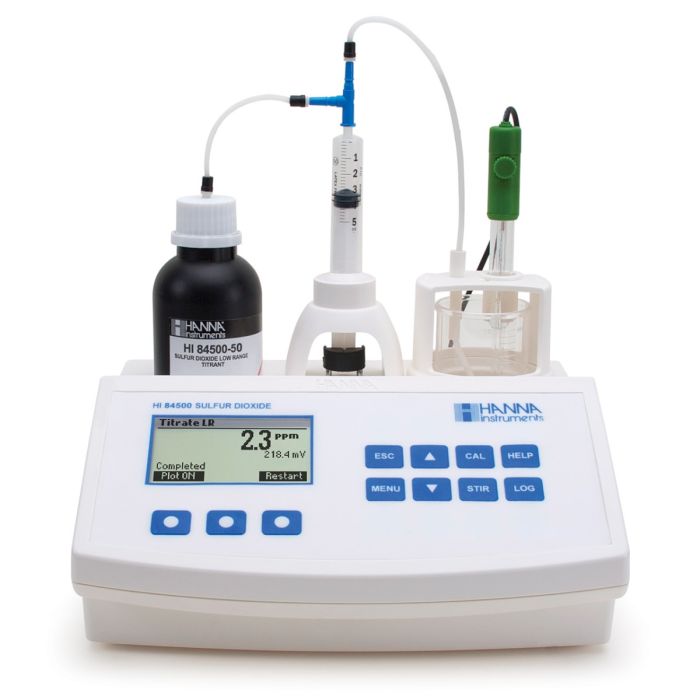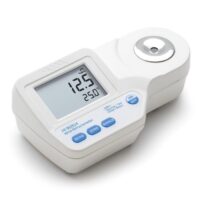Description
The HI84500 can be used to test for free and total SO2 in all wines, including red, which are difficult to test using traditional methods due to the inability to see the distinctive color change that occurs at the endpoint. The HI84500 offers a reliable, accurate, and fast way to analyze free and total sulfur dioxide. This mini titrator dispenses the titrant, detects the endpoint, and performs all necessary calculations automatically in a fraction of the time as compared to a manual titration. As found inTriage for Basic Wine/Grape Lab by Richard Carey, “the mini-titrator by Hanna reduces the time for an individual analysis by 75%.”
Winemakers add sulfur dioxide (SO2) to wine in order to inhibit bacteria and wild yeast growth and to serve as an antioxidant to prevent browning. When SO2 is added to wine, a portion of it becomes immediately bound while a remaining portion is unbound SO2. The portion that is unbound is also called free SO2 and it is responsible for protecting the wine. The bound and free SO2 together are referred to as total SO2. The relationship between the amount of SO2 added and the amount of free SO2 is complex, governed by the total amount of SO2 in the wine and the ability of compounds (e.g. sugars, aldehydes, keto acids, quinones, anthocyanin) to bind to the SO2. The exact relationship between free and bound SO2 will vary from wine to wine.
The amount of free SO2 depends on how much is added, how much was present before the addition, and how much was immediately bound. Free SO2 exists in two forms. The first form, bisulfite (HSO3–), is the predominant form but is relatively ineffective. The second form, molecular SO2, is the minor form and is responsible for protecting the wine. The amount of molecular SO2 available in wine is dependent upon the amount of free SO2 present and the pH. Typically 0.8 ppm of molecular SO2 provides adequate protection against bacteria growth and oxidation. In order to obtain this value for a wine sample that has a pH of 3.2 you would need 22 ppm of free SO2. If the pH was at 3.5 you would need double the amount of free SO2, 44 ppm.
|
pH
|
3.0
|
3.1
|
3.2
|
3.3
|
3.4
|
3.5
|
3.6
|
3.7
|
3.8
|
3.9
|
|
Free SO2
|
14
|
18
|
22
|
28
|
35
|
44
|
55
|
69
|
87
|
109
|
Application-Specific ORP Electrode The HI84500 is supplied with the HI3148B ORP electrode featuring CPS™ technology to prevent the clogging of the reference junction. Conventional electrodes may clog quickly in samples such as wine that have a high suspended solids content. By design, the HI3148B ORP electrode utilizes a ground glass/PTFE sleeve junction which controls a steady, predictable flow of electrolyte solution, keeping the junction open. The hydrophobic properties of PTFE repel wetness and coatings.
Piston Driven Dosing Pump The heart of the HI84500 is the piston driven burette pump. This type of dosing system uses a motor in which each dose is very precisely controlled and the volume dispensed is accurately determined. The piston driven burette is controlled dynamically so that the volume of titrant being dosed is automatically adjusted based on a voltage response of the previous dose. This type of dosing speeds up the titration process by allowing for more titrant to be dosed at the start of the titration and then very small doses as the endpoint is reached.
Automatic Stirrer The built-in stirrer is automatically maintained at a speed of 700 rpm, regardless of the viscosity of the solution being titrated.
On-Screen Features
Easy-to-Use Interface The HI84500 has an intuitive user design with clearly defined keys and a large screen that is easy to navigate. The meter has a built-in tutorial mode that, when enabled, will walk the user step by step through the titration process. A dedicated HELP key is always available to allow access to content-specific information during both calibration and titration.
Procedure Warnings Users are warned if there is an error in procedures such as the titration exceeded the maximum volume of titrant.
Graphic Mode This mini titrator displays in-depth data during titration, including a real-time graph of the titration curve.

Log-on-Demand The HI84500 allows for data logging of up to 400 samples: 200 titration results and 200 ORP/mV readings. Data can be stored and exported to a USB drive or a PC using the USB connection.
ORP/mV Meter In addition to being an automatic titrator, the HI84500 also can be used as an mV meter for direct ORP measurements.
|
Low Range
|
High Range
|
|
HI84500-50 Low Range Titrant (230 mL)
|
HI84500-51 High Range Titrant (230 mL)
|
|
HI84500-55 Calibration Standard (120 mL)
|
HI84500-55 Calibration Standard (120 mL)
|
|
HI84500-60 Acid Reagent (230 mL)
|
HI84500-60 Acid Reagent (230 mL)
|
|
HI84500-61 Alkaline Reagent (120 mL)
|
HI84500-61 Alkaline Reagent (120 mL)
|
|
HI84500-62 Stabilizer packets (100 pcs)
|
HI84500-62 Stabilizer packets (100 pcs)
|
Ordering Info
HI84500-01 (115V) is supplied with HI3148B ORP electrode, HI7082 electrode fill solution (30 mL), HI84500-50 low range titrant (230 mL), HI84500-51 high range titrant (230 mL), HI84500-55 calibration standard (120 mL), HI84500-60 acid reagent (230 mL), HI84500-61 alkaline reagent (120 mL), and HI84500-62 stabilizer packets (50 packets), 100 mL beakers (2), 20 mL beakers (2), scissors, dosing pump valve, 5 mL syringe, 1 mL plastic pipette, tube set (aspiration tube with titrant bottle cap and dispensing tube with tip), stir bar, cleaning solution sachets for wine deposits (2), cleaning solution sachets for wine stains (2), 12 VDC adapter and instruction manual.












